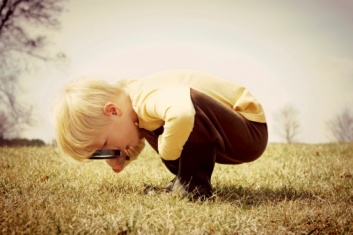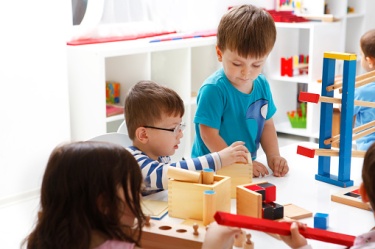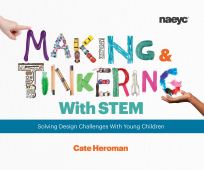In recent years there has been a push to include more science, technology, engineering, and math (STEM) skills in education. As the trend has shown success, educators have recommended the application of STEM activities in early childhood as well. Incorporation of STEM activities will help children observe, analyze, and make predictions about things in their environment. They will learn to fulfill their natural curiosity and develop inquisitiveness about subjects and how things work. They will also strengthen math skills beyond shapes, colors, and counting, such as analyzing quantities, measuring, collecting data, and recording results.

While the STEM movement drives innovation in America, there are many advocates that would like to add the A (arts) to STEM so it becomes STEAM. These advocates stress that the human brain is divided in half, and each half focuses on a different area of learning. The right side of the brain is in charge of intuition, creativity, and social skills. The left sides controls language, math, and cognitive thought. When both sides of the brain are stimulated, a person benefits by receiving a more well-rounded education. (Lipoff, Sarah. “Right Brain or Left Brain: Children and Creativity.” Funderstanding. 26 April, 2011. Accessed 21 March, 2017.)
Much of what preschool teachers and providers already do incorporates STEM/STEAM components. When a teacher encourages a child to observe, ask questions, collect and record data, and predict, he is encouraging the children to practice vital STEM skills. When a child sketches out a plan, finds creative uses for everyday materials, or explains how he came up with a solution to his peers, he is including the arts.
Teachers and providers can prepare a learning environment that will engage children and challenge them to think and design:

- Gather materials. Collect materials that can be used for creative exploration such as empty cardboard tubes, egg cartons, boxes, nature items, small manipulatives, adhesives, sculpting materials, containers, fabrics, and writing tools. Ask families to save and donate items as well to keep your supplies well stocked.
- Think safety. Offer safety items that provide general protection while working such as child-size safety glasses, low-temperature glue guns (adult use only), gloves, blunt-tipped scissors, etc. Many STEM/STEAM activities require the use of unconventional building materials that are not always offered as part of a typical preschool environment. These materials include items such as pulleys, magnets, adhesives, small manipulatives, or lengths of string and yarn. Supervise activities closely to make sure children use materials appropriately. Remove items that pose a safety risk immediately after finishing an activity.
- Organize and display materials. Display materials in such a way that they look attractive to children. Organize small materials in containers that are divided into sections. Suggestions include craft trays with dividers, cutlery trays, egg cartons, and muffin tins. Encourage children to return items back to their places if not used.
Once you are ready to introduce a design challenge, think about how long you plan for the activity to take. Will the project conclude after a short period of time or will it extend over a series of days? Solving problems and experimenting takes time! Allow for children to take activities to their level of capability. Block off a space or area of the room that can be used for tinkering. Allow for (child-safe) materials to remain out in this area for as long as the project lasts. Create a set of rules that are known by all children regarding who is allowed to manipulate the items within the designated space.
In the book Making and Tinkering with STEM by Cate Heroman, it is explained that engineers solve problems or make things work better by following a series of steps. These are the basic steps:
- Think about the problem: Discuss the challenge with the children. What are you hoping for them to do? Do they need to create or build something?
- Brainstorm ideas to create a solution: Ask the children to think of ways they might be able to solve the problem or what materials they might need to create or build. Keep items out of sight so the children have the chance to think about what might be needed. Have children create a plan. Provide paper and writing tools in case they wish to sketch out their ideas. (This puts the “Arts” in STEM so it changes to STEAM!)
- Create and build: Offer the requested materials and encourage children to build. Support them as they work without taking a lead role. This will encourage creativity (again, putting the “A” into STEAM). Observe closely so you can see how they are thinking. Explain what you see them doing, which will enhance their vocabulary. Try not to give too much information or make suggestions that will solve the problem for them. Ask questions to encourage them to think of additional solutions. For example, if the child is building a ladder out of sticks but it keeps falling over, you might say, “I can see your ladder is unstable and keeps falling over. What could you do to make it more stable?” It’s good to let children struggle with the problem for a bit. Give their brains time to process and think!
- Test it out: Have the children try their solutions. Did the solution work? If it did, ask how they knew what to do. If it didn’t work, ask them to think of changes they could make to change the results. Scaffold children’s learning by asking further questions or offering additional challenges.
- Revise to make it better: Ask the children if the solution works great or if changes could be made. This step can take place even if the solution appears to work. Encourage children to talk it over and work together to see if anyone has an idea for how to improve the current design.
- Share the results: Once the children are happy with the results of their solution, encourage them to share the results with their peers and family members. Encourage children to stand in front of the group as they describe the process they used to build or design. Allow other children to ask questions. Display the work where family members can see it so they can comment as well. Providing children with opportunities to speak in front of others and engage in conversation will allow them to practice appropriate social interaction and public speaking. This provides yet another way to incorporate the arts—turning STEM into STEAM!
Back to blog listing